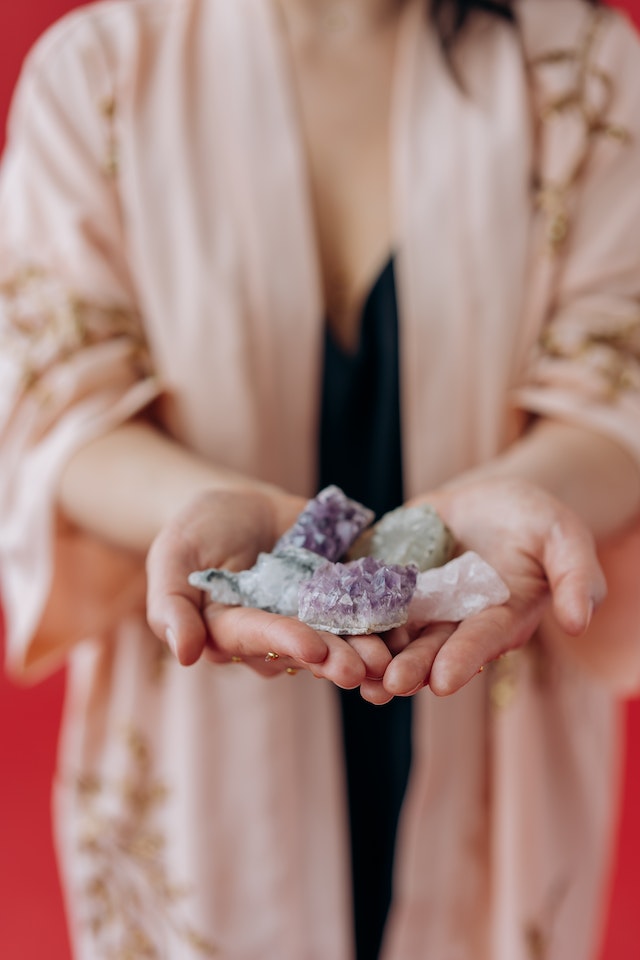
In the mystical realm of alternative healing, where ancient wisdom seamlessly intersects with modern spirituality, there exists a profound and awe-inspiring art known as Reiki. Derived from the Japanese words “rei” – meaning universal, and “ki” – referring to life energy, Reiki transcends the boundaries of conventional medicine, opening doors to the deepest recesses of healing for the body, mind, and soul.
At its core, Reiki harnesses the powerful universal life force energy that flows within and around us, empowering skilled practitioners to become conduits for healing. With gentle and nurturing touch or even simple intention, Reiki practitioners channel this vibrant energy to harmonize imbalances and restore natural equilibrium within the recipient.
Reiki, with its rich tapestry of healing traditions, serves as a testament to the profound interconnectedness of all living beings. It reminds us that we are not merely isolated islands but rather threads woven intricately into the fabric of existence. Providing solace for the wounded, guidance for the lost, and a pathway to self-realization, Reiki stands as a testament to the magnificent healing power that resides within each and every one of us.
Principles of Reiki
At the heart of Reiki lies a set of principles that serve as guiding lights for both practitioners and recipients alike. These principles, encapsulated in the traditional teachings of Reiki, provide a moral compass for living a harmonious and balanced life. Let us delve into these profound principles and explore the transformative wisdom they hold.
The Principle of Harmony
In the quest for holistic healing, embracing the principle of harmony becomes paramount. By cultivating harmony within ourselves and with the world around us, we tap into the innate power of interconnectedness. This principle reminds us to strive for balance, embracing the ebb and flow of life’s energies.
The Principle of Intention
Intention forms the cornerstone of Reiki practice. By setting clear and positive intentions, we align our energetic vibrations with the universal life force, empowering healing processes. With intention, we navigate the vast ocean of possibilities and guide the Reiki energy towards its highest purpose.
The Principle of Mindfulness
Mindfulness, the art of being fully present in each moment, lies at the core of Reiki practice. By cultivating mindful awareness, we heighten our sensitivity to the subtle energetic currents that pervade our being. Through this practice, we attune ourselves to the rhythm of the universe, enhancing our ability to flow with the healing energy of Reiki.

The Principle of Compassion
Compassion, a timeless virtue, radiates through the healing touch of Reiki. By approaching ourselves and others with compassion, we create a safe and nurturing space for healing to unfold. This principle reminds us to treat all living beings with kindness, recognizing their intrinsic worth and their potential for healing and growth.
The Principle of Gratitude
Gratitude, like the gentlest of whispers, infuses our Reiki practice with profound richness. By nurturing a grateful heart, we invite abundance and joy into our lives. This principle teaches us to appreciate the interconnected web of existence, acknowledging the contributions and blessings bestowed upon us by the universe.
The Principle of Self-Care:
Self-care forms an integral part of Reiki practice. By honoring our own well-being, we become vessels of healing, overflowing with vitality and compassion. This principle reminds us that we cannot give from an empty cup; therefore, we must prioritize self-care to sustain our ability to serve others.
The Reiki Healing Process
Embarking on a journey of Reiki healing is a mesmerizing experience, a dance between the seen and the unseen, the tangible and the ethereal. In this section, we will dive into the intricacies of the Reiki healing process, exploring each step with wonder and reverence. From preparation to integration, every phase holds its own significance, nurturing the profound transformation that takes place within the recipient.
Preparation
Setting the Sacred Space: Before delving into the healing process, it is essential to create a sacred space that invites tranquility and supports the flow of healing energy. This can be achieved by clearing the room of clutter, lighting candles, and playing soft, soothing music.
Cultivating Intentions: Intentions serve as guiding stars, directing the healing energy towards its intended purpose. Take a moment to reflect on the specific areas of healing you wish to address, setting clear and positive intentions for the Reiki session. Write these intentions down, allowing them to anchor your focus and attention.
Connection:
Opening the Channels: The practitioner will begin the session by connecting with the universal life force energy, channeling it through their own energetic system. They may use various techniques like breathwork, visualization, or hand positions to open and activate their energy centers.

Establishing a Healing Connection: Once attuned to the Reiki energy, the practitioner gently lays their hands on or above the recipient’s body, establishing a healing connection. The warmth and soothing touch serve as conduits for the flow of healing energy, creating a gateway to profound transformation.
Healing:
Flow of Energy: As the healing session unfolds, the practitioner navigates their hands over the recipient’s body, directing the healing energy to areas that require attention. The energy, guided by their intentions and the recipient’s innate wisdom, works to harmonize imbalances, release energetic blockages, and restore equilibrium.
Deep Relaxation: As the recipient surrenders to the healing energy, a state of deep relaxation ensues. Tension melts away, and the mind begins to quiet, creating an internal space for healing to take place on multiple levels – physical, emotional, and spiritual.
Integration:
Closing the Session: Towards the end of the session, the practitioner gently withdraws their hands, signaling the completion of the healing work. They may offer comforting words or guidance, reminding the recipient to take their time before resuming their day.

Grounding and Integration: After the session, the recipient is encouraged to take a few moments to ground themselves. This can be done by drinking water, taking gentle stretches, or simply sitting in stillness, allowing the energy to settle and integrate into their being.
Reiki Techniques and Variations
Within the vast and ever-evolving realm of Reiki, practitioners have delved into a myriad of techniques and variations, each offering its unique flavor to the practice. These techniques and variations serve as tools to deepen the connection with the healing energies and unlock greater potential for natural healing and transformation. In this section, we will explore some of the most widely used and celebrated Reiki techniques, inviting you to expand your understanding and embrace the richness of this ancient art.
Traditional Usui Reiki Techniques:
- Healing Hand Positions
In the traditional Usui Reiki system, practitioners learn a series of hand positions that correspond to different energy centers or areas of the body. These positions are often taught in a specific sequence and are utilized during a healing session to channel the energy to the recipient. By placing their hands gently on or above the body, the practitioner allows the healing energy to flow through their hands and into the recipient, promoting balance and well-being.
- Symbol Activation
Usui Reiki incorporates sacred symbols that hold specific energetic frequencies and intentions. These symbols are traditionally taught to Reiki practitioners during their attunement process and are used as powerful tools for amplifying and directing the healing energy. By visualizing or drawing these symbols, practitioners can enhance the energetic connection with the healing energy and invoke their unique qualities for specific healing purposes.
Karuna Reiki Techniques:
Karuna Reiki emerged as an evolution of the traditional Usui Reiki system, offering an expanded range of symbols and techniques for healing. Developed by William Lee Rand, Karuna Reiki incorporates additional symbols that focus on deep emotional healing and spiritual transformation. Some of the techniques commonly used in Karuna Reiki include:
- Chanting and Toning
Karuna Reiki practitioners often utilize focused sound frequencies to enhance the healing process. Through chanting or toning specific sounds or mantras, practitioners tap into the power of vibration to harmonize energetic imbalances and promote healing on a deep emotional and spiritual level. These sounds resonate with the energy centers of the body, facilitating the release of stagnant energy and supporting the integration of healing frequencies.
- Compassionate Healing
Compassion lies at the heart of Karuna Reiki, and practitioners are encouraged to cultivate a deep sense of compassion for themselves and others. By embodying loving-kindness and empathy, practitioners can create a safe and nurturing space for healing to unfold. Compassionate healing techniques in Karuna Reiki often involve visualizations and intention setting that focus on sending unconditional love and healing energy to oneself or a recipient.

Animal Reiki Techniques:
As beings intertwined with the natural world, Reiki practitioners have recognized the transformative power of Reiki for animals. Animal Reiki techniques incorporate gentle and non-invasive approaches that honor the unique needs and sensitivities of our furry, finned, and feathered friends. Some of the techniques commonly used in Animal Reiki include:
- Hands-Off Approach
Animals can be particularly sensitive to touch, and in some cases, they may not be comfortable with direct physical contact. Hands-off techniques in Animal Reiki involve working with the energy field of the animal, maintaining a respectful distance while channeling the healing energy. By observing the animal’s body language and energetic responses, practitioners can ensure a positive and soothing experience for the animal.
- Intuitive Connection
Animals communicate in a language beyond words, and Animal Reiki practitioners rely on their intuitive abilities to connect with them on a deeper level. By quieting the mind and opening themselves to the animal’s energetic presence, practitioners can establish a profound bond and understand the unique healing needs of the animal. This intuitive connection allows for a more personalized and tailored healing experience.
Reiki is a magical and transformative art that invites us to tap into the boundless healing energy that flows throughout the universe. With its principles of harmony, intention, mindfulness, compassion, gratitude, and self-care, Reiki offers a pathway to holistic well-being and self-realization. Through the sacred process of preparation, connection, healing, and integration, Reiki practitioners and recipients alike embark on a journey of profound transformation. Whether practicing traditional Usui Reiki techniques, exploring the depths of Karuna Reiki, or embracing the unique needs of our animal companions through Animal Reiki, there is a wealth of wisdom and techniques to explore within this ancient healing art. May Reiki continue to guide and illuminate the paths of those who seek healing and wholeness, reminding us of the infinite healing potential that resides within each and every one of us.
